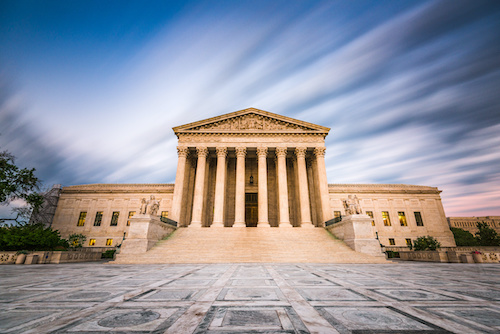“Thirty-one separate amicus briefs on the merits were submitted in this matter, and they present a wide variety of views on how the Supreme Court should handle the questions presented.”
 The U.S. Supreme Court has agreed to hear, on March 1, 2021, whether administrative patent judges (APJs) of the Patent Trial and Appeal Board (PTAB) of the U.S. Patent and Trademark Office (USPTO) are “inferior” officers properly appointed under the Appointments Clause of the U.S. Constitution (U.S. Const., art. II, § 2, cl. 2), and, if not, whether the “fix” by the Federal Circuit in Arthrex v. Smith & Nephew, 941 F.3d 1320 (Fed. Cir. 2019) worked.
The U.S. Supreme Court has agreed to hear, on March 1, 2021, whether administrative patent judges (APJs) of the Patent Trial and Appeal Board (PTAB) of the U.S. Patent and Trademark Office (USPTO) are “inferior” officers properly appointed under the Appointments Clause of the U.S. Constitution (U.S. Const., art. II, § 2, cl. 2), and, if not, whether the “fix” by the Federal Circuit in Arthrex v. Smith & Nephew, 941 F.3d 1320 (Fed. Cir. 2019) worked.
In separate petitions (now consolidated) from the same panel decision of the Federal Circuit in Arthrex, the U.S. and Smith & Nephew, as petitioners, are challenging the Federal Circuit’s declaration that PTAB APJs are principal officers of the United States and thus were appointed in violation of the Appointment’s Clause. Arthrex, as respondent, is defending the Federal Circuit’s conclusion that PTAB APJs are principal officers, but is itself challenging whether the “fix” of severing Title 5 protection of APJs after October 31, 2019 works.
Thirty-one separate amicus briefs on the merits were submitted in this matter, and they present a wide variety of views on how the Supreme Court should handle the questions presented.
On February 25, 2021, the New York Intellectual Property Law Association (NYIPLA), will be presenting a special webinar titled “Getting Ready for Arthrex Oral Arguments,” which will summarize the issues presented and include presentations by representative amici on their respective positions.
QUESTION 1
The first question accepted by the Supreme Court is: Whether, for purposes of the Appointments Clause, U.S. Const. art. II, § 2, cl. 2, administrative patent judges of the U.S. Patent and Trademark Office are principal officers who must be appointed by the President with the Senate’s advice and consent, or “inferior Officers” whose appointment Congress has permissibly vested in a department head.
Twenty-nine of the 31 amicus briefs submitted addressed this question.
Seventeen of the amicus briefs argued that the Federal Circuit erred in finding that PTAB APJs are principal officers, and 12 supported the position that PTAB APJs are principal officers.
The 17 amicus briefs that we think argue that APJs are inferior officers include those submitted by: Association for Accessible Medicine (AAM); Acushnet Company & Roger Cleveland Golf Inc.; American Intellectual Property Law Association (AIPLA); Apple Inc.; Askeladden LLC; Coalition Against Patent Abuse (CAPA); Computer & Communications Industry Association (CCIA); Cross-Industry Groups; eComp Consultants; Engine Advocacy and Electronic Frontier Foundation (EFF); High Tech Inventors Alliance (HTIA); Intel Corp.; Intellectual Property Law Association of Chicago (IPLAC); Administrative, Constitutional & Intellectual Property Law Professors; Jason V. Morgan; Niskanen Center; and Unified Patents.
In the NYIPLA’s upcoming webinar, five of these amici, namely eComp Consultants, AIPLA, Administrative, Constitutional & Intellectual Property Law Professors, Acushnet Company & Roger Cleveland Golf Inc., and Niskanen Center will summarize their respective positions in support of reversal on the first question.
The 12 amicus briefs arguing that APJs are principal officers include: 39 Aggrieved Inventors; Americans for Prosperity Foundation (APF); B.E. Technology, LLC; Cato Institute and Professor Gregory Dolin; Jeremy C. Doerre; Fair Inventing Fund (FIF); Joshua J. Malone; New Civil Liberties Alliance (NCLA); Pacific Legal Foundation (PLF); TiVo Corporation; US Inventor, Inc.; and US Lumber Coalition.
In the NYIPLA webinar, five of these amici, namely Jeremy C. Doerre, Cato Institute, NCLA, B.E. Technology, and Joshua J. Malone will summarize their respective positions as to why the Federal Circuit should be affirmed on the first question.
QUESTION 2
The second question accepted by the Supreme Court is: Whether, if administrative patent judges are principal officers, the court of appeals properly cured any appointments clause defect in the current statutory scheme prospectively by severing the application of 5 U.S.C. § 7513(a) to those judges.
With respect to the second question presented, 25 of the amicus briefs submitted addressed this question.
Seven of the amicus briefs argued that the Federal Circuit’s “fix” should be affirmed if the Court gets to the issue, two of the amicus brief argued that the “fix” should have been applied not only prospectively, but also retrospectively, and 16 amicus briefs argued for a different solution.
The seven amicus briefs which argued that, to the extent it is necessary, the Supreme Court should affirm the “fix” offered by the Federal Circuit included: AAM; Apple Inc.; CCIA; Cross-Industry Groups; EFF; HTIA; and Intel Corp.
The two amicus briefs which argued that, to the extent a “fix” was necessary, the Federal Circuit’s fix should also be retrospectively applied include those of Professor John Harrison and Professor Andrew Michaels. Both Professors will be sharing a summary of their arguments at the NYIPLA Webinar.
The 16 amicus briefs which argued for a different solution include: 39 Aggrieved Inventors; AIPLA; APF; B.E. Technology; CAPA; Cato Institute; FIF; Law Professors; Joshua Malone; Jason Morgan; NCLA; PLF; TiVo; UP; US Inventor; and US Lumber.
Of these, Unified Patents, AIPLA, 39 Aggrieved Inventors, Cato Institute, NCLA and US Inventor will be presenting summaries of their arguments in the NYIPLA webinar.
Register to attend the webinar (CLE credit available), here
Image rights acquired by AdobeStock

![[IPWatchdog Logo]](https://ipwatchdog.com/wp-content/themes/IPWatchdog%20-%202023/assets/images/temp/logo-small@2x.png)

![[[Advertisement]]](https://ipwatchdog.com/wp-content/uploads/2024/04/Patent-Litigation-2024-banner-938x313-1.jpeg)


![[Advertisement]](https://ipwatchdog.com/wp-content/uploads/2024/04/Artificial-Intelligence-2024-REPLAY-sidebar-700x500-1.jpg)
![[Advertisement]](https://ipwatchdog.com/wp-content/uploads/2024/04/Patent-Litigation-Masters-2024-sidebar-700x500-1.jpg)

![[Advertisement]](https://ipwatchdog.com/wp-content/uploads/2021/12/WEBINAR-336-x-280-px.png)
![[Advertisement]](https://ipwatchdog.com/wp-content/uploads/2021/12/2021-Patent-Practice-on-Demand-recorded-Feb-2021-336-x-280.jpg)
![[Advertisement]](https://ipwatchdog.com/wp-content/uploads/2021/12/Ad-4-The-Invent-Patent-System™.png)






Join the Discussion
5 comments so far.
Anon
February 23, 2021 07:20 amBP,
What is “fail to faithfully” mean?
If that means “apply independent judgment,” then which scene in Alice in Wonderland is evoked?
I suspect that we have a Ends justifying the Means undercurrent here.
Model 101,
I am not quite sure that I understand your position (given how typically you aim for strong patent rights).
By “there should be retroactivity” do you mean a) retroactivity in that panel judges were improperly appointed and thus all PTAB decisions are void — without the need for individuals to try to raise the issue now; or b) the ‘cure’ is an ‘automatic’ one, and that cure applies retroactively such that all PTAB decisions (even if properly prior void) are now solid, and there is no recourse for any challenge to any prior decision?
As you can see, depending on what you mean by “Should be retroactive,” there are polar opposite take-aways.
BP
February 22, 2021 04:03 pmJust remember what the dormouse said (PTAB APJ Amicus):
“APJs who fail to execute their duties faith-fully can reasonably expect to be held accountable by the Secretary and Director, who themselves serve at the pleasure of the President.”
“The Federal Circuit’s focus on ensuring that the Secretary and Director have unfettered removal authority undervalues the important role that removal protections have in strengthening public confidence that decisions of the PTAB accord with the law and are grounded in impartial fact-finding. Specifically, these rights promote transparency in any efforts the Secretary and the Director take to exercise control over PTAB decision-making.”
Hmm . . . after the promise of lifetime appointment (many under the panel stacker Dir. Lee), the APJ says, “sure, we can be ‘held accountable'” (without citing evidence/proof particularly as to “accountable” being or including removal); yet, as to unfettered removal authority, the APJ says “we don’t want that” (hence, principal officers).
Be held “accountable” by the Director/Secretary but without “unfettered removal authority” to be fired by the Director/Secretary.
OK APJ, here’s a slap on the hand, a meaningless wink-wink (what an APJ calls “being held accountable”), while lifetime employment continues . . . . Give me a break.
The APJs want removal protection rights without any meaningful way for them to be held accountable. To me, that sounds like arguing that the APJs are Principal Officers (i.e., unconstitutionally appointed).
Why not enumerate all the ways an APJ can act unfaithfully and the corresponding “holdings of accountability” and why such an APJ should ever lay hands on another applicant’s/patentee’s rights?
“This Court should seek to limit the judicial remedy as narrowly as possible so that any negative repercussions incurred while
waiting for a legislative remedy can be mitigated through executive action such as discretionary recognition of removal protections.”
Interesting to see the tables turned on an APJ . . . . Maybe it will result in more empathy for applicants/patentees?
Model 101
February 21, 2021 09:40 pmAnother dead horse race.
Should be retroactive.
Pro Say
February 21, 2021 08:17 pmThankfully, SCOTUS always get things right with patent cases (yes; yes, I know this isn’t “strictly” a patent case).
Always.
Anon
February 21, 2021 05:26 pmLooking forward to a summary of the summaries.
I do wonder how many positions will be noted as “this is the law, but the law should be changed because [ ] — as opposed to differing views of what the law IS.